Get to the fun part
To make something irresistible, get to the fun part — fast. That’s how Exploding Kittens became one of the world’s most popular games. When cartoonist Matthew Inman (The Oatmeal) and game developer Elan Lee (former Xbox) designed the card game Exploding Kittens, they took fun very seriously. This mindset unlocked their creativity in unexpected ways: They transformed a Kickstarter into a wildly successful interactive game, and radically simplified their instructions so their players could get to the fun part faster. In their story, you’ll find surprising lessons for any field on serving your audience and feeding your own creativity.
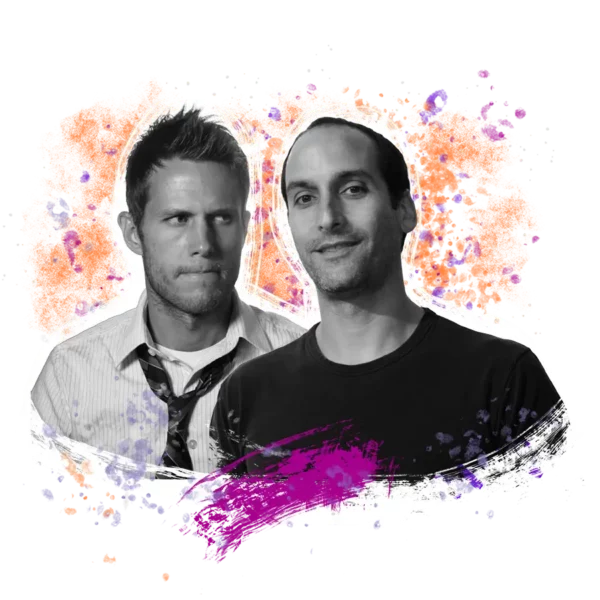
Transcript
Table of Contents:
- Chapter 1: I was part of the problem
- Chapter 2: The spark that lit the fuse
- Chapter 3: In which Matt enters the story
- Chapter 4: Designing the cards. The ugly, strange, cute cards
- Chapter 5: The Kickstarter Campaign: Day 1
- Chapter 6: Kickstarter Campaign — Day 7
- Chapter 7: Is this game any fun?
- Chapter 8: The custodians of fun
- Chapter 9: If it feels bad, get rid of it
- Chapter 10: An actual company
- Chapter 11: What Exploding Kittens means to us now
Transcript:
Get to the fun part
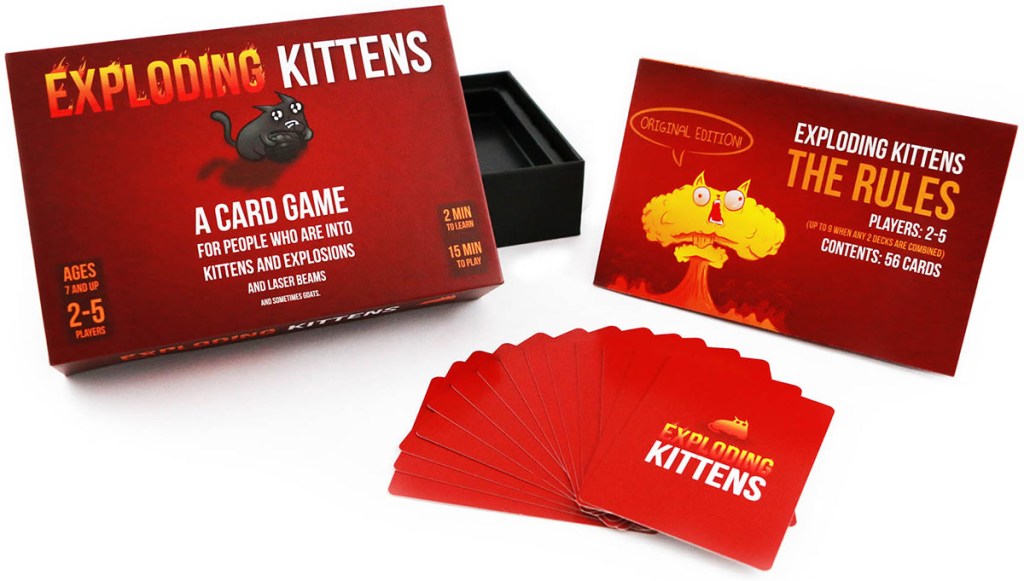
Chapter 1: I was part of the problem
ELAN LEE: I walked to my brother’s house. I walk in the front door and I’m like, “Hey, everybody, I’m here. I’m so excited to see everybody.” My brother has two young kids and they were both just glued to the screen, this video game they were playing. To make it worse, it was a video game that I helped design.
I was the chief design officer at the Xbox. Everything I did involved putting people in front of screens, building games where all the focus was on the games instead of the players. And as a result, the players became isolated. And so I was clearly part of the problem.
Within two weeks, I resigned from Microsoft, thinking, “I can’t be part of this problem anymore. I need to start working on solutions.”
When I think back to my childhood playing games with my siblings, I don’t even remember the games. What I remember is the joy. I remember laughing. I remember throwing food. I remember forming secret alliances. I remember cheating. The games were just the tool set to allow us to have those experiences. I resolved to start a new kind of entertainment company that celebrated connectivity.
JUNE COHEN: That’s game developer Elan Lee. Later, you’ll hear from his creative partner, cartoonist Matthew Inman, and they’re about to tell us the story of creating Exploding Kittens — one of the most popular card games in the world.
This is Elan and Matt’s personal story of developing a simple and hilarious card game that snowballed into an entire company. But the takeaway is relevant for any creative in any field: to make something that people find irresistable, get to the fun part.
As Elan and Matt take us on the journey of creating Exploding Kittens, you’ll hear how they intentionally build fun into everything — from the card design to the instruction manual. And you’ll learn how they transform a fundraising campaign into an epic interactive game — one that involves cats dressed as tacos and 10 batmans in one hot tub. Stay tuned.
And here’s what you need to know about Elan, Matt, and the card game Exploding Kittens.
Before Exploding Kittens, Elan, as you heard, was Chief Design Officer for XBox at Microsoft. He helped develop some of the world’s first Alternative Reality Games. Matt is the creator of the beloved and wildly popular webcomic called The Oatmeal. In the course of the interview, you’ll occasionally hear Elan reference Matt himself as “The Oatmeal.”
As for Exploding Kittens, it was created in 2015 — and was originally funded through Kickstarter, the crowd-sourcing platform. The game raised more than $8.7 million, making it the most-backed project in Kickstarter’s history at the time. To date, over 18 million games have been sold.
Elan and Matt now run Exploding Kittens, Inc., which creates many charming and hilarious tabletop games — including my personal favorite, called Throw Throw Burrito — as well as mobile app games. A Netflix series based on Exploding Kittens is scheduled for release in 2023. [Recorded ALT: And there’s now a Netflix series based on Exploding Kittens.]
I’m your host June Cohen, and on this episode, you’ll hear original music composed for prepared piano. For visuals while you’re listening, go to sparkandfire.com
[THEME MUSIC]
Chapter 2: The spark that lit the fuse
ELAN LEE: Russian roulette has always been fascinating to me because it’s nuts: the fact that that game exists, that anyone has ever played. For those who don’t know, it’s so awful. Take a revolver, it holds six bullets, put one bullet in it, spin the chambers, aim at your own head and pull the trigger and hope you don’t die. You see it in movies all the time to illustrate that someone is certifiably nuts.
I had this moment brainstorming with a buddy of ours named Shane Small. We thought: “Okay, what if there was a gamified version of Russian roulette?”
What if you tried to play that with a deck of cards?” We called it Bomb Squad. There were 50 cards and there was one bomb. It’s ticking. It’s in the deck somewhere. The only thing you want to do is avoid having it explode. Fireworks started going off in my head. I think this is at least worth spending some time on.
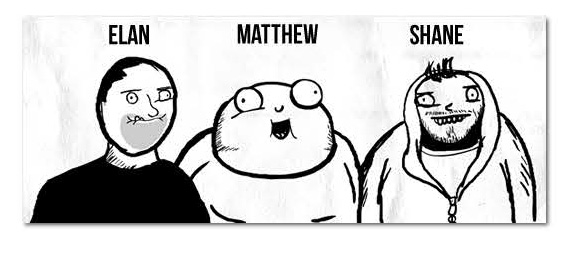
The co-creators of Exploding Kittens: Elan Lee, Matthew Inman, and Shane Small.
Chapter 3: In which Matt enters the story
How do you bring more fun to an already great idea? Add a twist.
MATT INMAN: We’d met once at a dinner, but we must have said five words to each other. We have a mutual friend. Matt Harding is a dear friend of ours.
ELAN LEE: Matt was this great connector. He arranged a vacation in Hawaii.
MATT INMAN: 12 of us rented a house.
ELAN LEE: You could walk to the ocean in probably a hundred steps. Waves crashing and palm trees in the wind, had that beautiful ocean smell and these incredible sunsets.
MATT INMAN: This is how dorky we are. In the corner, just some massive stack of all the games people had brought. So even though we had paradise at our disposal, you could tell it’s a bunch of nerds who want to play games.
ELAN LEE: I had this poker deck: king, queen, ace, the whole bit. And I’d taken sharpies and scribbled all over all the cards to simulate what I wanted Bomb Squad to be.
MATT INMAN: When a friend says, “I have a card game I made with a sharpie, do you want to play it,” usually the response is, groan. “Oh God.” You know what I mean? Most card games are awful, and then being homemade is even worse. So when I played it, my expectations were low.
ELAN LEE: I don’t know if I’ve ever told you this, Matt, but I was having quite a bit of a fanboy moment. Here I was meeting The Oatmeal and instead of doing all the fun stuff that we’re supposed to be doing, he wants to play my dumb card game.
MATT INMAN: And we ended up playing it all weekend. I thought, “This is a great game. This is so fun.” Replay-ability is huge. Most importantly, the longer you play, the more exciting the game gets because the stakes get higher and higher. And I said to him, “When we play Bomb Squad, everybody’s afraid of the bomb. What if just everybody’s scared of kittens?” The sweetest thing in the world, scary little kittens. And so that became Exploding Kittens.
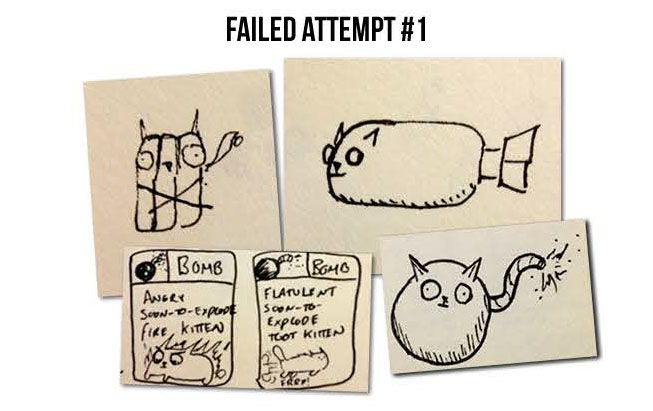
The actual Exploding Kitten, failed attempt 1
JUNE COHEN: Did you hear the momentum in Matt’s voice once he realized that Elan’s homemade card game was actually … fun? It inspired Matt to take the game to a whole new level with scary, little kittens. And they were off.
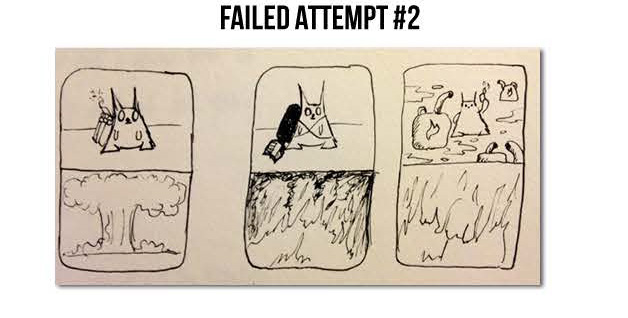
The actual Exploding Kitten, failed attempt 2
Chapter 4: Designing the cards. The ugly, strange, cute cards
What’s the best way to get started? Don’t get stuck in the details. Jump to the fun part.
MATT INMAN: My mom used to bring home butcher paper, the big rolls of paper that would go on forever. My brother and I … we had dinosaur costumes that we put on. We’d match and we’d lay on the floor and just draw Braveheart-style stick figure battles. We’d only have a black pen and a red pen. The black pen was to draw the stick figures and the red pen was just to draw all the viscera and blood. We thought it was hilarious. I don’t… I can’t excuse this. I don’t know why we thought that was so funny, but we loved it.
What I was doing was jumping to the fun part — methodically drawing a human figure and then adding detail later isn’t fun. What’s fun is get the stick figure out of the way and then go to the bloody crazy violent GI Joe stuff.
One of the toughest things to do as a cartoonist is to make someone laugh in one frame. The Far Side is a great example. His comics are amazing and he did it in one frame. Easiest way to do it is to just write absurd things. So for instance, I have a card where you grow the thousand year back hair, where your back hair grows like it’s a thousand years old and it’s huge and someone’s getting tangled up in back hair.
If they’re not ugly and strange, I go for cute. Taco Cat’s a good example. Taco Cat is a palindrome. It’s the same spelled forwards and backwards. It’s a cat that’s a taco. I don’t know how else to pitch that idea.
I’ve found in comedy, the less detail, the more the comedy shines. A good example of this would be South Park, where most of the characters are just simple ovals. The animation is incredibly crude. The simplicity of the art actually lends to the joke.
That’s why Exploding Kittens, the art is incredibly simple, to get to the fun.
Chapter 5: The Kickstarter Campaign: Day 1
ELAN LEE: We had the deck, a handshake agreement, and a desire to put this thing up on Kickstarter as soon as possible, because we didn’t know what the hell we were doing, so why not go really fast?
ELAN LEE: Am I going to embarrass myself in front of The Oatmeal? Knowing that Matt was taking a big risk on this thing, what I was going to stress about is: Is this going to end in a, “Well, that was fun. Let’s never speak again.”
MATT INMAN: I was like, “This is going to be the greatest thing the world has ever seen. Build a city on this thing. There’s going to be a theme park.”
I had this massive following and I was always just terrified of making a big loud money grab and my audience would, for whatever reason, set me on fire.
There’s this timidness that comes with being creative where a business person sells something and they shove it in your face and say, “Yeah, buy, buy, buy.” And an artist sells something and they apologize for it. Like, “Oh, this is garbage. You sure you want this?”
ELAN LEE: When you set up a Kickstarter page, you have to say how much money you expect to raise within those 30 days. If you do not raise that amount, the campaign is canceled. All that gets returned. End of story. We just thought, “All right, well, we’ll just set it at the minimum.” 200 copies of the game would cost us $10,000.
The other thing you need for a Kickstarter campaign is you need a bank account. I went to the local bank down the street and I told them, “Hey, we’re launching this thing and we need to open a bank account.” And they said, “Okay, cool. How do we know if fraud is happening on this account? What is the largest check that could possibly go into this account?” I said, “Well, we’re trying to raise $10,000, so $10,000 is the largest.” And the woman at the bank was like, “Have some ambition here. $10,000 is way too low. This campaign’s going to be great. I have so much faith in you. Let’s set it higher.” And I said, “Okay, how about $20,000?” And she said, “How about $100,000? You can do it. Go get ’em.”
30 days later, I get a call from the bank saying they’re trying to deposit a check for $9 million and every alert in the world has gone off, and what do we do?
That first day, we hit our goal of $10,000 in seven minutes. This was an absolute runaway train. That was terrifying.
MATT INMAN: I was so excited. I’m just like, “Oh, my god, kittens and fire and money. Oh, this is amazing.” I was just acting like an idiot.
I was driving my girlfriend to the airport. I had a Tesla, which used to sound cool, but now makes me sound like a douchebag. But that’s a whole other thing we won’t talk about.
My girlfriend, she was like, “Are you high?” We just started dating and she’s like, “Literally, are you on cocaine?” I’m like, “No, no. I got this cats and the card game,” and blah, blah, blah.
ELAN LEE: I’m watching not the dollar amount go up, I’m watching the number of backers go up. Every time that number moves, that’s another box I have to stuff and send out a game to. That got so stressful that I took a bunch of sticky notes and put them on my computer monitor so that that number was blocked out. I could still watch the community, see what people were saying, without having to stare at that terrifying number.
MATT INMAN: I put the Kickstarter up on the web browser in the Tesla, just acting like a moron driving my stupid car with my stupid touchscreen.
ELAN LEE: I texted Matt a picture of my monitor. I was like, “This is so scary. I’m so nervous right now. Look at what my monitor looks like. And Matt of course texted back to me a picture of his Tesla with the Kickstarter campaign on the screen just saying, “Look how well we’re doing.” Everything I could have expected, all my fears and aspirations, were obliterated by the tidal wave that is The Oatmeal fan base.
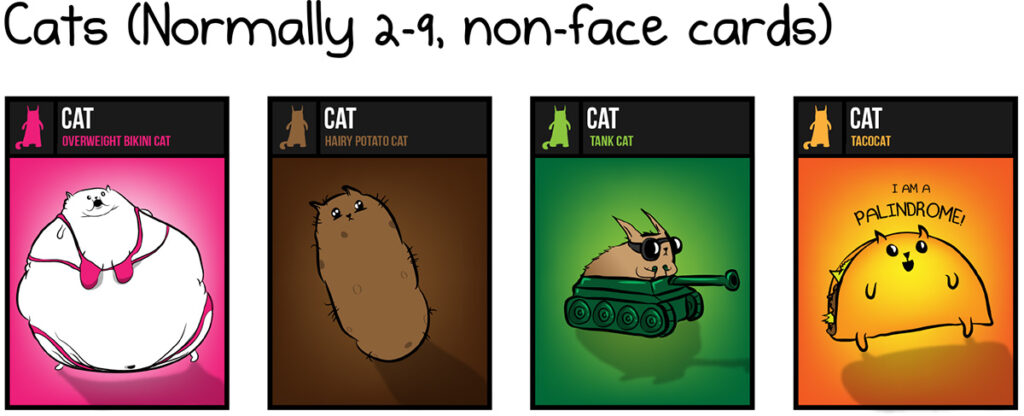
Taco Cat and other characters from the Exploding Kittens deck.
Chapter 6: Kickstarter Campaign — Day 7
What do you do after you achieve all your goals? Well, you can try to do something fun.ELAN LEE: Matt and I went on a trip. It’s called the JoCo Cruise. It’s a boat full of geeks and nerds and comedy performers and musicians, and it’s just a bunch of geeks hanging out on a boat for a week. We’re one week into the Kickstarter campaign and we’re watching the numbers really go off a cliff here.
The one tool that most Kickstarter creators have is stretch goals. Which is, “Okay, backers, we’re trying to raise $10,000 and everyone’s going to get their game. But if we stretch and we raise 20,000, everybody gets a free carrying case. And if we raise 50,000, we’ll add five more cards to the deck.”
We’ve already broken most Kickstarter records at that point. It’s really disingenuous for us to ask for more money. We had a decision to make. We can either just sit back and say, “It is what it is. We’ve already been successful beyond our wildest dreams. We’re done. Let’s just see where this thing ends on its own,” or we can try to do something fun.
The idea that we came up with was to change what stretch goals are. Instead of tying it to money, what if we just ask you to do funny, silly, ridiculous things? For example, one of the characters in the game is Taco Cat. It’s half taco, half cat. It’s this adorable character.
MATT INMAN: My finest work.
ELAN LEE: It’s my favorite character in the whole game. If you show us 10 pictures of real taco cats, dress your cats up as tacos or however you interpret it, we’ll add five extra cards to the deck. Show us real beard cats, however you interpret that. Show us a picture of 10 Batmans in one hot tub. If you are willing to have fun with us and play and be silly with us, we’ll just keep making the game better. And they did. They did these incredible things. There was this wonderful side effect of people saying, “Hey, this is fun. Hey, I’m going to tell my friends about it.” And it just so happens that the page where you have fun and you tell your friends about, also happens to have this wonderful button that says, “I want this product. Take my money.”
We basically said, “Look, for the next 30 days, we’re not going to take this seriously anymore. We’re going to throw a party and everybody’s invited.”
MATT INMAN: Rather than, “Give me 20 bucks and I’ll send you a card game in a couple months,” instead, it was, “Give me 20 bucks. Let’s hang out and do goofy stuff together.” It turned an experience that was transactional into a game.
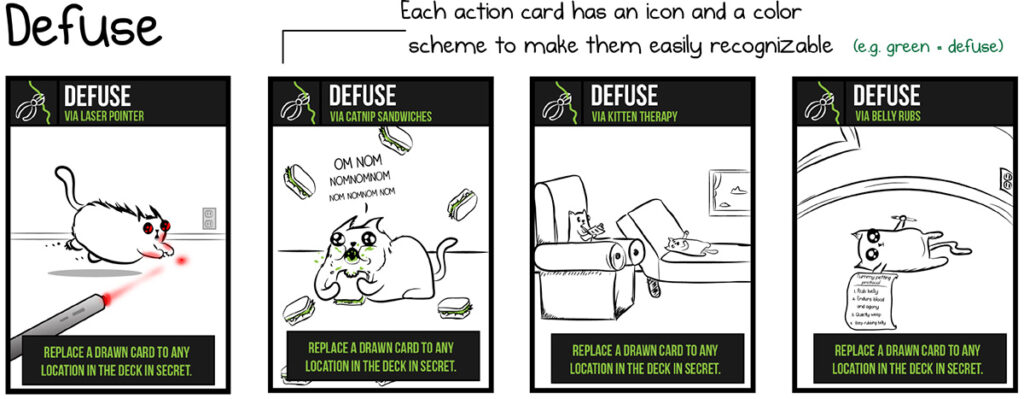
Matthew Inman’s notes on the Defuse cards highlight how simple — yet effective — each individual card is.
Chapter 7: Is this game any fun?
MATT INMAN: We had played the game with each other and we knew it was fun. You put this out into the world and no one has played it. Is it a fun game, objectively?
ELAN LEE: All of our previous play testing was us in the room telling people how to play. When they have questions, we answer them. When they make a mistake, we correct them. And so we ensure that they’re having the optimal play experience because we’re right there to babysit that. When we’re not in the room, when you get a box and you open it and it’s just free play, the instructions have to do all of that work. Instructions are so much harder than I thought they would be.
MATT INMAN: Half the games I own, I never play them because I open it up and the instructions are this Bible-length document. I can’t understand them and I don’t want to spend three hours learning.
ELAN LEE: I just figured, “Let’s make the cards do a bunch of work. Instructions should be really short. Let’s optimize. Let’s be as efficient as possible.” The very first version of the instructions, it basically said, everyone has a hand of seven cards. On your turn, play any cards you want, do whatever the cards say, and then draw a card to end your turn. To learn what all the cards do, just read the text on the cards. That was it.
We sent them out to a whole bunch of friends as a play test [with] these very long feedback forms. “Did you understand this part?” and “Describe the setup of the game and describe how it ended,” and all this stuff.
And then I asked people, “Was this any fun?” And we got a hundred percent no. Every single play-test family said, “No, we don’t even understand how to play this game. We were playing the game and then I ran out of cards, so I think I won.”
It took us a few months of tweaking those instructions, interviewing more people, fresh eyes on the thing. People had never seen it before. I remember just obsessing over those things for months.
MATT INMAN: We would do something like, “All right, draw a card. If it’s this card, you do this, unless that, and then this.” First step, they’re overloaded. They’re like, “I can’t memorize all this stuff.” Instead, you start with the core and you repeat it and you repeat it and you repeat the core of what the game is. Don’t explode; draw a card. Don’t explode; draw a card. Then you throw all your edge cases and all your weird stuff at the very end. That way people at least can get going without having to get mired in all of the details.
ELAN LEE: And I realized that if we ask, “Did you have fun,” they’re just kind of sugarcoating it and they’re trying to butter us up, anyway, so: That’s not a good question. We changed the feedback form to just be one question: “When you finished playing, did you want to play again?” And we started getting mountains of those surveys back and the answers were all, “Yes,” a hundred percent of them to the question, “Did you want to play again?” Yes, yes, yes, yes, yes, yes.
They’re all on one side of the page, really simple to read.
MATT INMAN: Don’t explode; draw a card. Don’t explode; draw a card.
ELAN LEE: And then there’s the giant block that says, “Stop reading. If questions come up, we’re pretty sure all those questions are answered on the backside of this page. But you don’t even need to read the backside until those questions come up. You’ve got everything you need. Go play.”
JUNE COHEN: “Go play.” That’s Matt and Elan’s rallying cry. Their goal isn’t just to explain the game, it’s to get the explanations out of the way. And that’s something that applies to any field. Clear the way, so your audience can jump to the fun part.
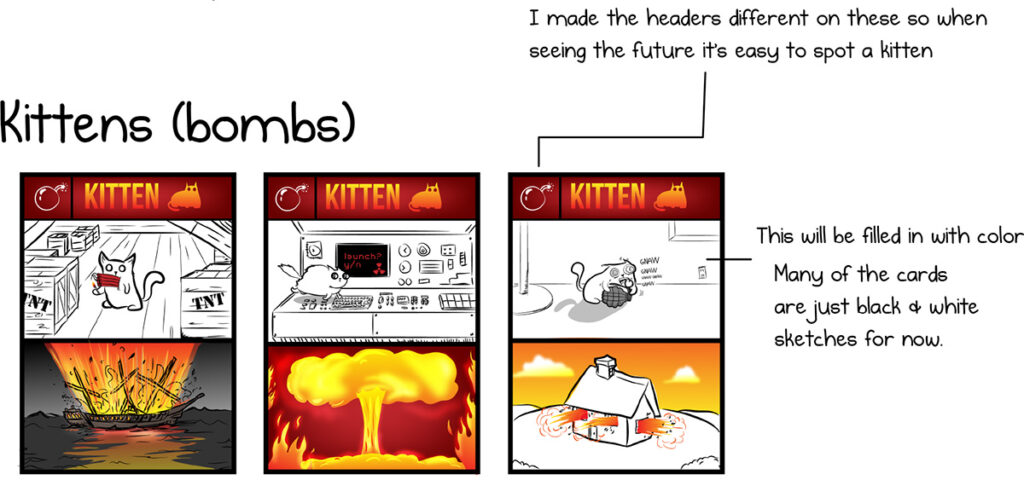
Matthew Inman’s notes on the first set of kittens (bombs) in the Exploding Kittens deck.
Chapter 8: The custodians of fun
How do you deliver on an impossible promise? Find your logistics wizard.
ELAN LEE: 700,000 copies of the game sold in 30 days.
When we thought we were making just a hundred or so copies of the game, we were working with this woman named Sherry. She owned a company built to help people exactly like us. She was going to handle all of the manufacturing, the warehousing. And we said, “We think we want this minimum print run of just a few hundred orders. If you can manufacture them, if you can get them on the boats, if you can get them to my garage, we’ll have a little pizza party. I’ll order pizza and beers, we’ll invite all our friends over and we’ll stuff boxes and we’ll mail out these things.”
After the first 24 hours, my phone rang and it was Sherry. And I picked up the phone and she just started screaming. It was a mixture of panic and elation. She’s just like, “You’re 24 hours in, and this is already the biggest order I’ve ever had to deal with.”
It was very clear I don’t have a big enough garage for this.
One of the things you put on your campaign page is the expected delivery date. We had said our expected delivery date was six months. Nobody’s going to hold you to that in theory; but in reality, everybody holds you to that.
Basically, everyone told us the same thing. 700,000 orders, you cannot make that date. There’s just not enough time. What was at stake at that moment was our initial reputation as a provider of games. We talked this big story about, “Trust us and give us your money and we will be the custodians of fun.” And we had every opportunity to not make good on that promise and just one opportunity to actually fulfill it. We now have 700,000 promises to keep. Matt and I took that very seriously.
MATT INMAN: But I also felt like if we didn’t, this wasn’t my fault and I could point fingers at Elan. Because I’m not “logistics guy.” I’m the creative man. You can’t ship boxes from China? How hard is that? But it actually is quite hard.
ELAN LEE: We’re going to have to deploy a lot of the solutions that giant companies like Hasbro and Mattel scale end up deploying in order to fulfill this many orders.
We didn’t exactly know what we were doing at first. We got a lot of help. We made a lot of phone calls. We cashed in a lot of favors.
MATT INMAN: Carly was employee number three, Carly McGinnis. And she was all new at this.
ELAN LEE: I met Carly… I interviewed her to be my assistant when I was at Microsoft. And then when we started Exploding Kittens, I asked her to come over and help out.
MATT INMAN: And she was our savior. She is the logistics production wizard. Her brain has everything Elan and I’s do not. Doesn’t consider herself a creative person. She considers herself the giant mathematical calculation ship moving pit bull that we needed to actually ship 700,000 games.
ELAN LEE: I’m really, really proud to say that with all that stress and all that pressure, we delivered every single one of those games on time.
Chapter 9: If it feels bad, get rid of it
ELAN LEE: In the original game there is what’s called a favor card. The comic on the favor card says, “Get enslaved by party squirrels.” And it’s a picture of a guy on his hands and knees looking very miserable and there’s a group of squirrels having a party on his back. He’s miserable, they’re happy. There’s the gag. We got a note. It was just saying, “Listen, I have to tell you the story of something that happened. We’re a mixed race family, so we talk a lot about race issues. And my son is such a huge fan of your game and he loves everything and we read all the cards and we laugh. And when we got to this one, he asked me about the word “enslaved.” And we had a very good conversation. And when he asked why it was in this game that was bringing him so much joy, when the word was triggering of so many negative connotations,” she said, “I couldn’t answer that and I was wondering if you could help me out.”
Matt and I had a conversation about it and we thought, “Well, that was just irresponsible of us.” That shouldn’t be in the game. If the whole point of the game is joy and laughter and bringing people together, this feels bad and we don’t want to feel bad and we don’t want people to have a bad experience. So we redesigned the card. The new gag is, it’s a cowboy getting a horsey ride except the horse is riding on the cowboy’s back.
We actually were able to put in a little Easter egg. The kid’s name is actually hidden inside this updated art. I got to go to their house and present the new game, the new card to him. It was so wonderful to see their reaction and I love that this kid, this 8-year-old kid, now has a secret that only he knows. I’m being very careful not to say how his name is hidden or how to find it because it’s his. And now he goes to school, he gets to brag to all his friends. It belongs to him. I love that we’re still learning. I love that we can always make the game better. It makes me very happy that we get to update the game in a positive way.
Chapter 10: An actual company
How do you growa up, without losing the fun? Remember why you started.ELAN LEE: Our company was so informal for such a long time. It was just a few of us in a garage.
MATT INMAN: Two, three years in, as the headcount of the company grew, I was just like, “Oh, this is actually a company.” Having your own coffee maker and a space you rented for an office, it felt different.
ELAN LEE: Carly McGinnis realized very early on that in order for us to succeed, we have to now transition from Kickstarter into retail and online sales. And that’s a beautiful statement but so hard to implement. And it is because of that Herculean effort that not only are we still around, but we’re one of the biggest independent game companies in the world. If you look at the top 10 Kickstarter campaigns of all time, and eight years in, we’re still very much a part of that list. I looked about two years ago and of the 10, all of them had gone bankrupt except for us. The reason for that is Carly McGinnis.
MATT INMAN: She is the greatest employee we’ve ever hired. We got so lucky for employee number three.
ELAN LEE: And now she is the president of the company.
When we got to the 60- or 70-person mark and we had to have an HR department, they said, “We need a company mission statement.” We looked at each other and we’re like, “Why don’t we just formalize the thing that we’ve been saying anyway, which is games should not be entertaining. Games should make the people you’re playing with entertaining.”
MATT INMAN: The motivation behind a lot of our card games is that it’s trying to make that relationship more with each other rather than with the media itself. It’s fostering these memories.
ELAN LEE: I was traveling somewhere, I was at an airport, and the flight was delayed. It was delayed four hours and there were no other flights and there were a few hundred of us in the terminal and everyone was miserable, except for this one group of kids who was sitting in a circle on the floor just laughing and giggling. And I walked over and I looked and sure enough, they’re playing Exploding Kittens. I remember thinking, “This feels important.” We set out to make a source of joy for people and I am currently staring at evidence of success.
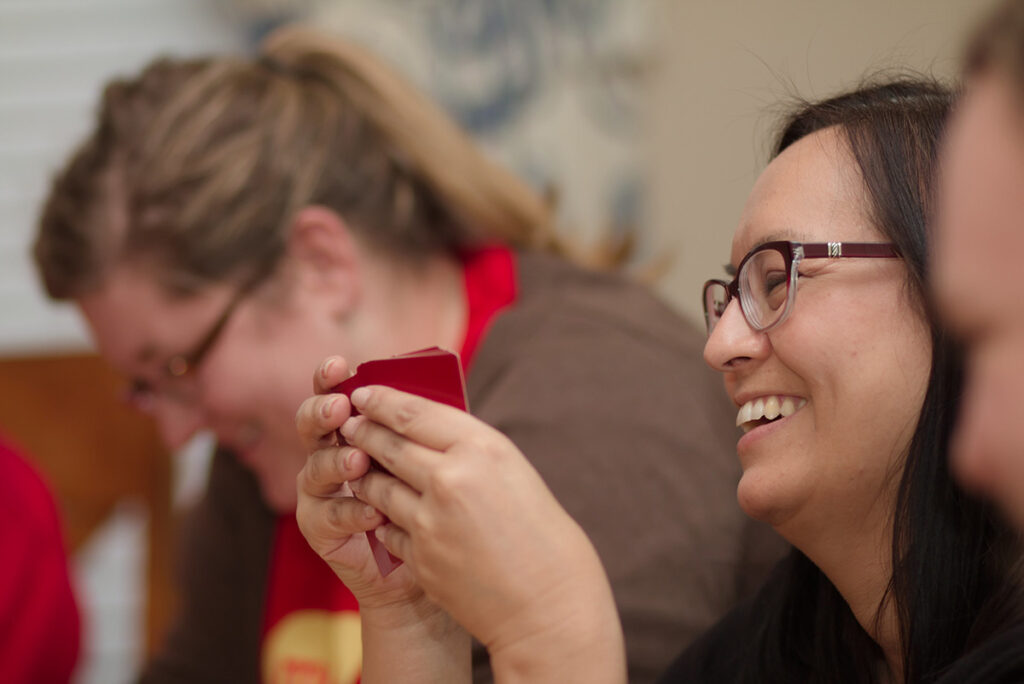
The internet is full of images of happy people playing Exploding Kittens. This great shot is from Jeff Jackowski via Flickr.
Chapter 11: What Exploding Kittens means to us now
MATT INMAN: When Exploding Kittens started, I was like, “This is a side project. Let’s get these damn cats out of the way and I can go back to doing what I’m good at, cartooning or whatever.”
I read an interview with Trey Parker and Matt Stone from South Park. They made a movie right when South Park was getting popular. And they actually were telling each other, “This movie’s going to be huge. This is our legacy. This stupid cartoon about kids in Colorado, whatever. Let’s — the movie, the movie, the movie.” And I might be suffering from that same thing.
It’s been eight years. We have 80 employees. We sold 20 million copies.
ELAN LEE: Yeah, it’s one game every six seconds, at this point.
MATT INMAN: Yeah. And I still think that way. I’m still like, “Just get these damn cats out of the way. I can go back to writing stories.” And there’s part of my brain that just wants to go back to this other thing, and I think I’m missing the good thing.
ELAN LEE: This woman wrote to us and she said, “We play your game every night. It’s a big part of our family culture and I’m pregnant. I want to announce it to my husband. Can you write me a card to do so?” And so we wrote her a card. It’s called the Human Storage Card, and it’s a picture of her with a little pseudo x-ray showing there’s a baby in her tummy. We produced it professionally and we mailed it to her and she played it and that was how she announced to her husband that she was pregnant. She sent us these incredible pictures back of the tearful, joyful moment that that was, and I look at stories like that and I just think this is such beautiful, clear evidence that we have created something that is a net positive in the world, that people look at as a source of joy. To get to play a small part in that, it’s the thing I’m in love with. It’s the thing that gets me up in the morning and makes me look forward to every single day.JUNE COHEN: I want to thank Elan and Matt for sharing their story with us. I hope you heard things in it you can bring into your own creative work.
It might be what happened when Matt made the simple switch, swapping exploding bombs for exploding kittens. Or the way he jumped to the fun part in his cartooning — whether it’s drawing stick figures with his brother as a kid, or creating ridiculous characters like Taco Cat. Or it might be the way Matt and Elan simplify and simplify the instructions until 100% of participants want to play again.
About the Creators and Host


